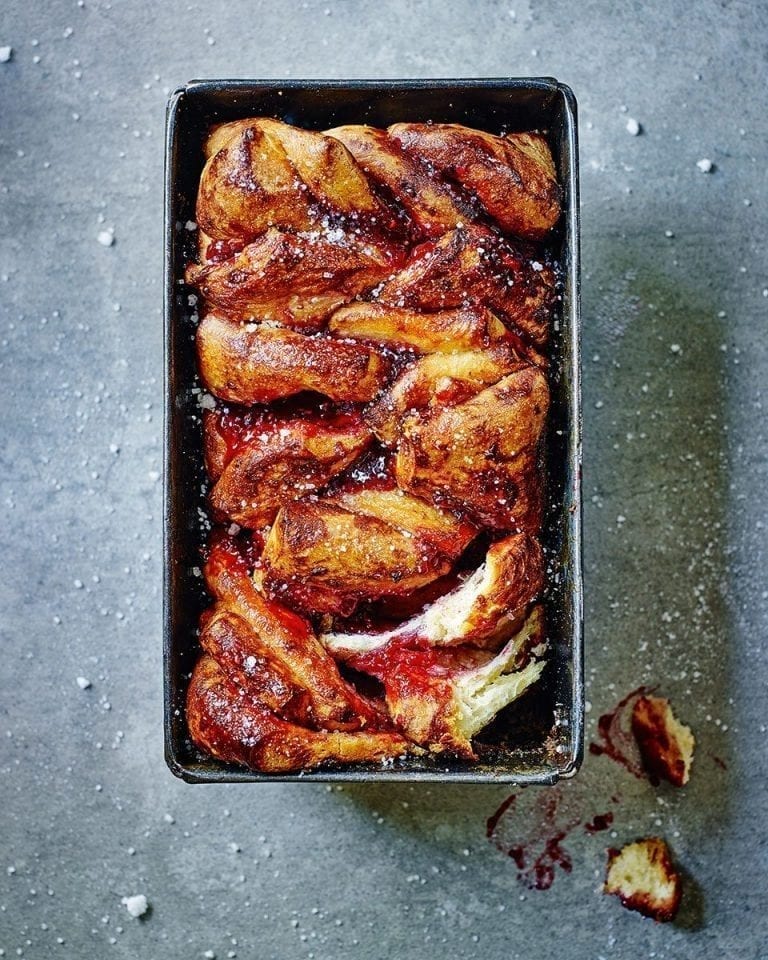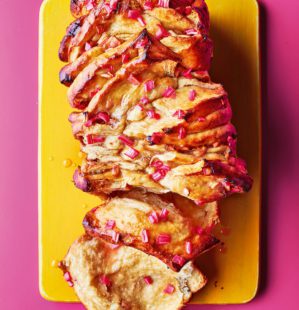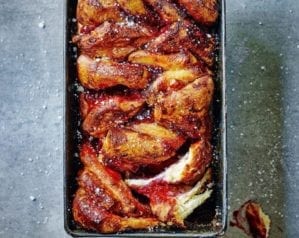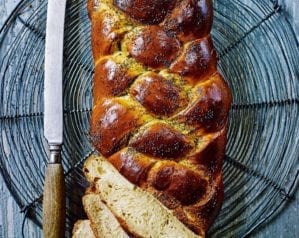
Breakfast brioche
- Published: 6 Jul 18
- Updated: 18 Mar 24
This warm, jam-filled brioche is the best smell to wake up to in the morning. Why not spoil your mum with this decadent homemade breakfast on Mother’s Day? Make sure she shares it with you – it’s next-level amazing.

This recipe uses the pull-and-slap technique. Use any leftover brioche in pain perdu.
-
Serves 10-12
-
Hands-on time 1 hour, oven time 50 min, plus rising and proving
Ingredients
- 5g fast-action dried yeast
- 10g caster sugar, plus a sprinkle
- 300g strong white bread flour, plus extra for dusting
- 1 level tsp salt
- 45ml warm milk, plus extra to brush
- 3 large free-range eggs, beaten
- 200g unsalted butter, very soft, cubed, plus 50g melted and extra to grease
- Sea salt flakes to scatter
- ½-¾ jar raspberry/cherry/apricot jam
You’ll also need…
- 900g wide loaf tin, buttered, and the base lined with baking paper
Method
- Mix the yeast, sugar, flour and salt in a mixing bowl, make a well in the centre, then pour in the milk and eggs. Mix with a palette knife (or dough hook in a stand mixer) to form a soft dough.
- Knead the dough for 10-15 minutes until smooth and elastic. If doing this by hand, you might need a dough scraper. Tip the dough into a greased bowl, cover with a tea towel and leave to rise until doubled in size (about 2 hours).
- Add the 200g butter, a piece at a time, using the pull-and-slap technique . Put the dough on an unfloured surface, pull half of it up, then bury a piece of butter in the dough on the table. Slap the pulled dough down, then pull up a new section and slap this down. Repeat pulling and slapping until the butter is incorporated, then add another piece of butter. Don’t add it too quickly or it won’t incorporate. The dough will turn shiny and very soft. (Alternatively, do this in a stand mixer, still adding the butter a bit at a time.)
- Put the dough to the bowl and leave to double in size again. Don’t leave it anywhere too warm, or the butter may melt and make the dough greasy.
- Knock back the dough to distribute the air, then roll it out on a lightly floured surface to a rough 30cm x 45cm rectangle. Brush the top with melted butter, scatter with a little salt, then spread jam all over. Using a sharp knife, halve the dough, then cut each half into 3 strips. Cut each strip into 4 rough squares. Put them in the tin to fill it haphazardly. Cover with oiled cling film and leave to prove for 40 minutes.
- Heat the oven to 180°C/160°C fan/gas 4. Once the dough is puffed, brush with milk, then bake for 45-50 minutes until golden and cooked – cover with foil once the top is golden (after about 25 minutes). Cool for 10 minutes in the tin, then run a knife around the edge and carefully invert from the tin. Leave until lukewarm, glaze with more jam, then sprinkle with sugar and pull apart to eat.
- Recipe from April 2016 Issue
Nutrition
- Calories
- 327kcals
- Fat
- 19.8g (11.9g saturated)
- Protein
- 5.8g
- Carbohydrates
- 31g (12.2g sugars)
- Fibre
- 0.5g
- Salt
- 1g
delicious. tips
If you’re kneading by hand, we recommend you add three-quarters of the liquid, then see if it needs the rest (some flours take more liquid than others). If the dough really is too wet to knead, add an extra handful of flour.
A plastic dough scraper is useful when hand-kneading wet, sticky dough – find them in all good cookshops or on Amazon.
You can leave the dough to rise overnight in the fridge. Bring it back to room temperature before shaping and proving.
You can also freeze dough after kneading: freeze in an airtight freezer bag, easing out as much of the air as you can before sealing. Defrost completely, then let the dough puff up again before shaping and proving. After overnight rising or freezing, it may take a bit longer than usual to prove.
Buy ingredients online
Rate & review
Rate
Reviews
Subscribe to our magazine
Food stories, skills and tested recipes, straight to your door... Enjoy 5 issues for just £5 with our special introductory offer.
Subscribe
Unleash your inner chef
Looking for inspiration? Receive the latest recipes with our newsletter










